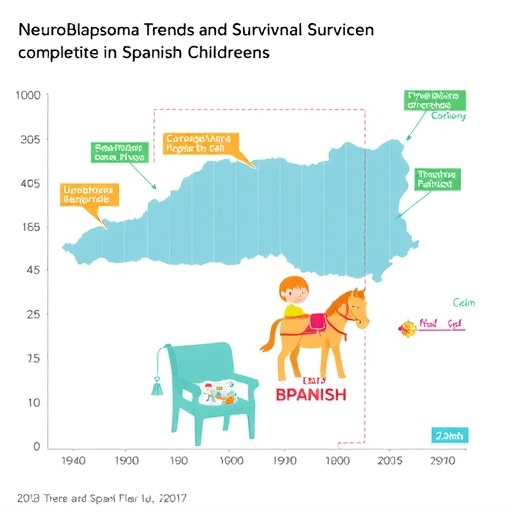In a groundbreaking longitudinal study spanning over two decades, researchers in Spain have meticulously analyzed the incidence and survival patterns of neuroblastoma, the most common extracranial solid tumor affecting children. Drawing from a robust dataset that merges two comprehensive national databases — the Spanish Registry of Childhood Tumors (RETI-SEHOP) and the Spanish Neuroblastoma Clinical Database (NBL-CDB) — the study offers unparalleled insights into the dynamics of neuroblastoma in Spanish children aged under 15 years, exploring shifts in diagnosis stages and survival outcomes from 2000 through 2021.
Neuroblastoma, a malignancy arising from neural crest elements of the sympathetic nervous system, poses considerable challenges for pediatric oncology due to its heterogeneous nature and variable clinical courses. Advances in risk stratification and treatment modalities have revolutionized prognosis over recent years, but understanding the epidemiology through population-based data remains critical to guiding future interventions. This Spanish investigation, with an extensive sample of 1,774 cases, translates raw statistics into a refined understanding of temporal trends and treatment impact on survival.
The age-standardized incidence rate for neuroblastoma in Spain during the studied interval stood at 14.0 cases per million children aged 0–14 years. This rate is consistent with figures reported in other high-income countries, underscoring the relatively stable prevalence of this disease in developed health care settings. Importantly, the distribution of disease stage at diagnosis—critical for prognosis—remained remarkably stable over the 22-year period. Such stability highlights potential areas for concerted early detection efforts and refined staging protocols.
Survival analysis revealed a heartening improvement in five-year overall survival (OS) rates, rising significantly from 74% in the early 2000s to 81% by 2017. This increment is more than statistical—it reflects real-world advancements in therapeutic regimens and supportive care. Stratified survival analyses illuminated striking disparities, with survival outcomes influenced by sex, age at diagnosis, tumor morphology, primary tumor site, and, crucially, disease stage.
Further nuanced inspection revealed that males and children with locoregional tumors benefitted most noticeably from survival gains, suggesting a differential impact of emerging therapies and clinical management strategies. The study authors link these gains to innovations such as anti-GD2 immunotherapy, which targets neuroblastoma cells with high specificity, and the commencement of pivotal clinical trials like the LINES trial (EudraCT 2010-021396-81), highlighting the critical role of clinical research in transforming patient outcomes.
The incorporation of stage data collection in cancer registries, as advocated by the Toronto Guidelines, emerges as a vital tool for delineating disease trajectories and tailoring interventions at a population level. By validating the importance of standardized staging data, this research sets a precedent for cancer registries globally, underscoring that nuanced clinical data collection can translate into public health advancements.
Underlying these encouraging trends is a testament to the synergy between epidemiological surveillance and cutting-edge oncology, demonstrating how data-driven approaches can directly feed into therapeutic innovation and improved patient prognostication. The Spanish experience serves as a compelling case study in balancing registry completeness with clinical detail to derive actionable insights.
The methodology employed in this study embodies rigorous epidemiological principles, leveraging cross-linkage between registries to mitigate underreporting and enhance data completeness. Employing Kaplan-Meier survival estimates alongside Cox proportional hazards models stratified by age groups, the researchers distilled complex interactions influencing survival, rendering a sophisticated statistical portrait of the disease.
Beyond epidemiology, this research sheds light on the biological heterogeneity inherent in neuroblastoma, with tumor morphology and primary site emerging as critical determinants of survival. Such findings pave the way for integrating molecular and histopathological profiling into registry frameworks to refine risk stratification further.
The Spanish neuroblastoma cohort’s stability in stage distribution over two decades points to persistent challenges in early diagnosis. This observation raises compelling questions about underlying factors such as access to healthcare, awareness campaigns, and potential biological reasons for late presentation, warranting focused public health initiatives.
Moreover, sex-based survival differences suggest potential biological underpinnings or differential responses to therapy that merit targeted investigation. Understanding whether these disparities are driven by genetic, hormonal, or socio-environmental factors will be crucial in achieving equitable outcomes.
The study also acknowledges the critical role of clinical trials in advancing neuroblastoma treatment, highlighting that participation in studies such as the LINES trial has translated into measurable survival benefits. This relationship emphasizes the importance of integrating research into standard care to ensure that breakthroughs reach patients promptly.
In conclusion, this comprehensive Spanish study not only confirms that neuroblastoma incidence remains steady but also chronicles a reassuring upward trajectory in survival, driven by advances in therapeutic strategies and clinical trials. It highlights the indispensable value of detailed, stage-specific data collection in cancer registries and provides a blueprint for leveraging epidemiological data to guide future pediatric oncology research and policy.
The implications reach beyond Spain, offering hope and direction to countries striving to improve outcomes for children afflicted by neuroblastoma. As immunotherapy and precision medicine continue to evolve, ongoing registry-based surveillance will be pivotal in validating their impact on population health, guiding resource allocation, and ultimately improving survival trajectories worldwide.
Subject of Research: Incidence and survival patterns of neuroblastoma in Spanish children under 15 years over a 22-year period.
Article Title: Incidence and survival among children with neuroblastoma in Spain over 22 years.
Article References:
Alfonso-Comos, P., Cañete, A., Briz-Redón, Á. et al. Incidence and survival among children with neuroblastoma in Spain over 22 years. BMC Cancer 25, 1548 (2025). https://doi.org/10.1186/s12885-025-14877-4
Image Credits: Scienmag.com




